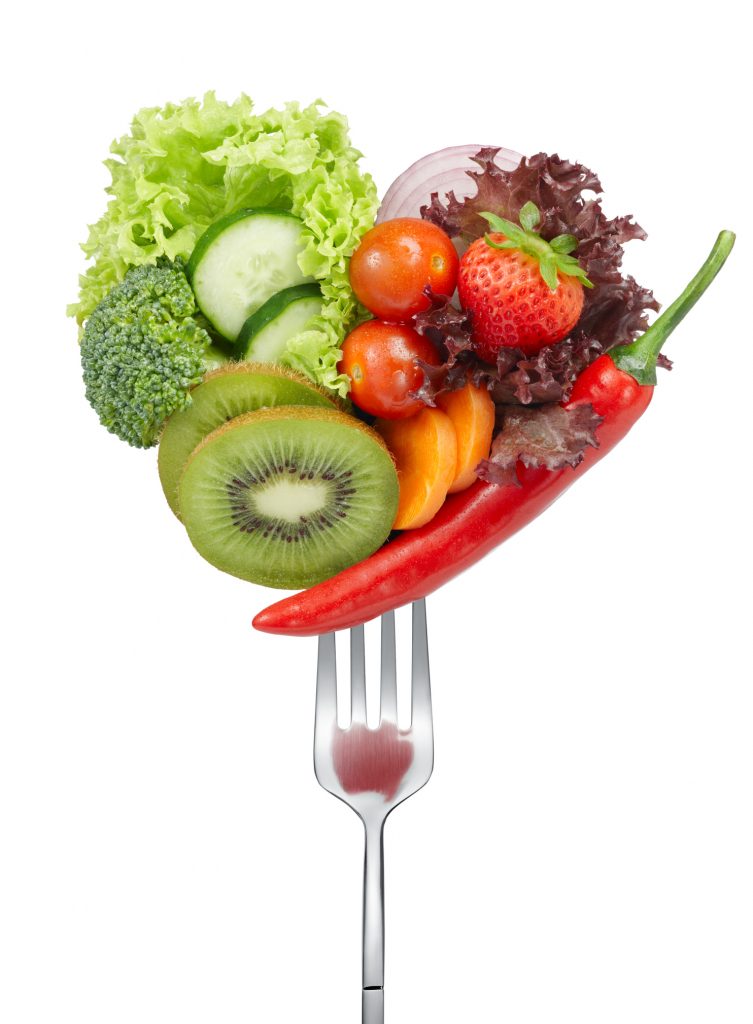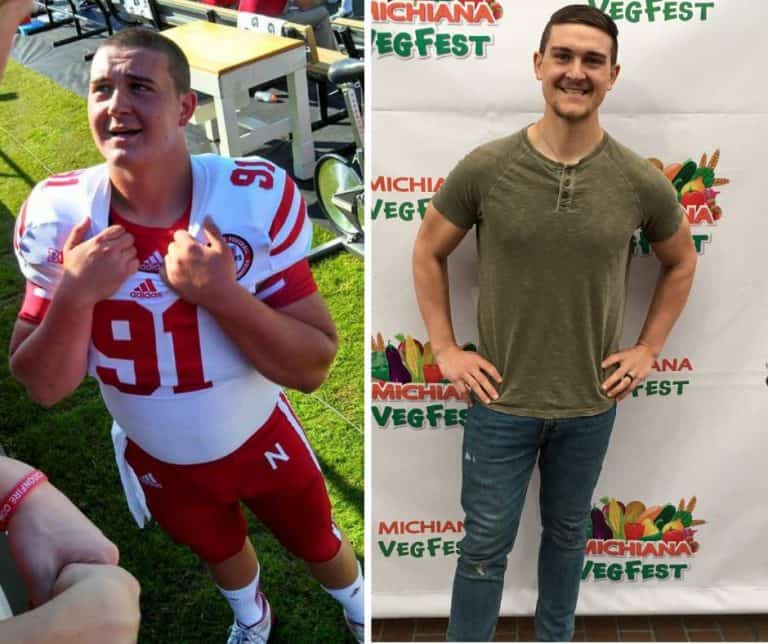Losing Weight on a Plant-Based Diet
In this article, Neal Barnard, MD, author, and president of the Physicians Committee for Responsible Medicine (PCRM), shares his tips on how to Lose Weight on a Plant-Based Diet. You could be one of the next plant-based inspiring stories.

You may be wondering where in the world to begin. Our plant-based starter kits are a great way to begin because they include a book, a set of DVD lectures from Dr. Neal Barnard, and a folder full of helpful literature from the Physicians Committee for Responsible Medicine. This list of 70+ Plant-Based Meals can help beginners and motivate others who might be interested in the food healthy vegans eat.
If you are trying to lose weight, going vegan will help enormously.1 For starters, there is no longer even a drop of animal fat on your plate. That’s great because every gram of fat holds 9 calories. That’s a lot more than are in carbohydrates or protein (just 4 calories per gram).
Fat in foods
To take an example, white meat chicken–even without the skin–is about one-quarter fat, as a percentage of calories. In contrast, nearly all foods from plant sources–beans, grains, vegetables, and fruits–derive less than 10 percent of their calories from fat. So if you are skipping animal products and building your meals from plants, you’re skipping a lot of unwanted calories.
Fatty foods pack in the calories
| 1 gram of carbohydrate, sugar, or protein = 4 calories 1 gram of fat = 9 calories |
There are a few fatty foods in the plant world that you will want to be cautious about: vegetable oils, nuts, seeds, and avocados pack a fair amount of fat. Yes, their natural plant oils are much healthier than animal fats (most animal fats are high in saturated fat that raises cholesterol levels and is linked to Alzheimer’s disease, while most plant-derived oils have very little saturated fat). Even so, all fats and oils have 9 calories in every gram.
So, if weight loss is your goal, it’s good not just to avoid animal products, but also to minimize oily foods, such as nuts, peanut butter, guacamole, and oils used in cooking. You will soon see what a difference this step can make.
Setting goals
What’s a good goal? If you are aiming for weight loss, a total of 20 to 30 grams of fat in a day’s meals is a good limit. That is much less than what most people get. But, it is easily achieved when you’re skipping animal products and limiting fatty foods.
If you are tracking your fat intake, fruits, vegetables, and other foods in the produce aisle do not have nutrition labels, so don’t worry about them. For packaged foods, favor those that have no more than 2 to 3 grams of fat per serving. You’ll see that, over the course of the day, you’ll stay under your fat limit.
Cut the fat
In addition to avoiding animal products, here are some easy ways to cut the fat and all the calories that go with it.
- Instead of frying in oil, try sautéing in water, in vegetable broth, or even in a dry pan (e.g., for onions or garlic).
- Skip nuts and nut butters. Yes, peanut butter and roasted almonds are tasty, but they are very high in fat calories.
- Top salads with nonfat dressing, lemon juice, balsamic vinegar, horseradish, or seasoned rice vinegar instead of oily dressings.
- On a sandwich, use mustard or pickle relish instead of mayonnaise. A squirt of seasoned vinegar works great on a sub.
- On toast, there is no need for butter or margarine if you’ve bought a good quality bread.
- Top baked potatoes with black pepper, mustard, or salsa instead of butter.
Fiber: Your weight-loss friend
For powering weight loss, it also pays to think about fiber–that is, plant roughage. Yes, “fiber” is a boring word from nutritional science. But it really does pack health power. Here’s why: Fiber is filling but has essentially no calories.
So although you might imagine you have eaten quite a lot, the truth is that fiber reins in your appetite and keeps your calorie intake in bounds. With high-fiber foods on your plate, you will push away from the table before you have overeaten.
Animal products have no fiber at all–zero–which is another reason why meaty, cheesy diets tend to fatten people up. But every bite of vegetables, fruit, beans, and whole grains includes fiber.
At the top of the list is our humble friend the bean. Check out the numbers.
Fiber in common foods (in grams)
| Black beans (1/2 cup) | 6 |
| Baked beans (1/2 cup) | 5 |
| Broccoli (1 cup) | 5 |
| Apple (1 medium) | 4 |
| Brown rice (1 cup) | 4 |
| Oatmeal, cooked (1 cup) | 4 |
| Orange (1 medium | 3 |
| Banana (1 medium) | 3 |
| Whole-grain cereal (1 cup) | 3 |
| White rice (1 cup) | 2 |
| Whole-grain bread (1 slice) | 2 |
| White bread or bagel (1 slice) | 1 |
| Spaghetti, cooked (1/2 cup) | 0.5 |
Notice that, although whole-grain cereals brag about their fiber, the real fiber champs are beans and vegetables. And whole grains are better than refined grains.
Notice what happens when brown rice sheds its bran coating to become white rice. It loses half of its fiber. That is also the case when you compare white bread to whole-grain bread.
So, to power your weight loss, you’ll want to put beans, vegetables, and fruits front and center in your routine, and favor whole grains over refined grains.
Summing it up
Simple, isn’t it? By avoiding animal products, keeping oils low, and emphasizing high-fiber foods, you can make your weight loss easy–even without counting calories or saying no to seconds. These foods are naturally modest in calories, and they satisfy your brain’s natural satiety mechanism so that your appetite turns off.
Our research also found that a vegan diet gently boosts your metabolism in the after-meal period.2 In other words, after people have been following a vegan diet for a few weeks, their bodies are better able to turn calories into body heat, rather than storing them as fat.
The effect is small–your after-meal metabolism increases about 16 percent. But considering that the effect lasts three or more hours after each meal, it adds up to a helpful extra calorie burn.
Exercise
What about exercise? It helps, too, but modestly so. Running full tilt for two miles burns fewer calories than are in a 20-ounce soda. So, exercise in addition to eating a healthy vegan diet, not instead of it.
Extra weight-loss power
| Avoid all animal products |
| Keep oily foods (vegetable oil, fried foods, nuts, seeds, avocados) to a minimum |
| Boost high-fiber foods |
This article is from The Vegan Starter Kit, by Dr. Neal Barnard, MD, Grand Central Publishing Company, New York. Another helpful article from Dr. Barnard is High Fiber Diet Benefits.
For those of you new to the whole food plant-based lifestyle, we’ve created a FREE 7-Day Plant-Based Menu Planner to help you get started!
About the author

Neal Barnard, M.D. is a physician, clinical researcher, author, a fellow of the American College of Cardiology, and an adjunct associate professor of medicine at the George Washington University School of Medicine and Health Sciences.
As president of the Physicians Committee for Responsible Medicine (PCRM), Dr. Barnard leads programs advocating for preventive medicine, good nutrition, and higher ethical standards in research. His research contributed to the acceptance of plant-based diets in the Dietary Guidelines for Americans. In 2015, he was named a Fellow of the American College of Cardiology. In 2016, he founded the Barnard Medical Center in Washington, D.C., as a model for making nutrition a routine part of all medical care.
Working with the Medical Society of the District of Columbia and the American Medical Association, Dr. Barnard has authored key resolutions, now part of AMA policy, calling for a new focus on prevention and nutrition in federal policies and in medical practice. In 2018, he received the Medical Society of the District of Columbia’s Distinguished Service Award. He has hosted four PBS television programs on nutrition and health.
Dr. Barnard works with patients with diabetes, obesity, and other chronic conditions in clinical research studies, aiming to improve the prevention and treatment of these health problems.
Other scientific articles on WFPB nutrition
- Vegan Sources of Calcium
- A Physician’s Perspective on COVID-19, Inflammation, & Nutrition
- Protein: The Building Block of Life
- How to Start a Plant-Based Diet: Fast Way vs Slow Way
- Healthiest Foods to Eat Daily
- Top Plant-Based Doctors and Experts
- Diet for Heart Health and More
- The Starch Solution | Dr. McDougall’s Personal Journey
Plant-Based Weight Loss Success Stories
Citations
- Barnard ND, Levin SM, Yokoyama Y. A systematic review and meta-analysis of changes in body weight in clinical trials of vegetarian diets. J Acad Nutr Diet. 2015;115:954-969.
- Barnard ND, Scialli AR, Turner-McGrievy G, Lanou AJ, Glass J. The effects of a low-fat, plant-based dietary intervention on body weight, metabolism, and insulin sensitivity. Am J Med. 2005;118:991-997.





I’ve been practicing a WFPB diet for at least 10 years now. It’s not the animal that I crave it’s the sugar. What can I do to overcome this?
Hi Sandra- I’m betting this podcast from Dr. Neal Barnard might be very helpful. https://www.pcrm.org/news/exam-room-podcast/diet-myths-5-sugar-addiction-and-dehydrated-foods-losing-nutrients